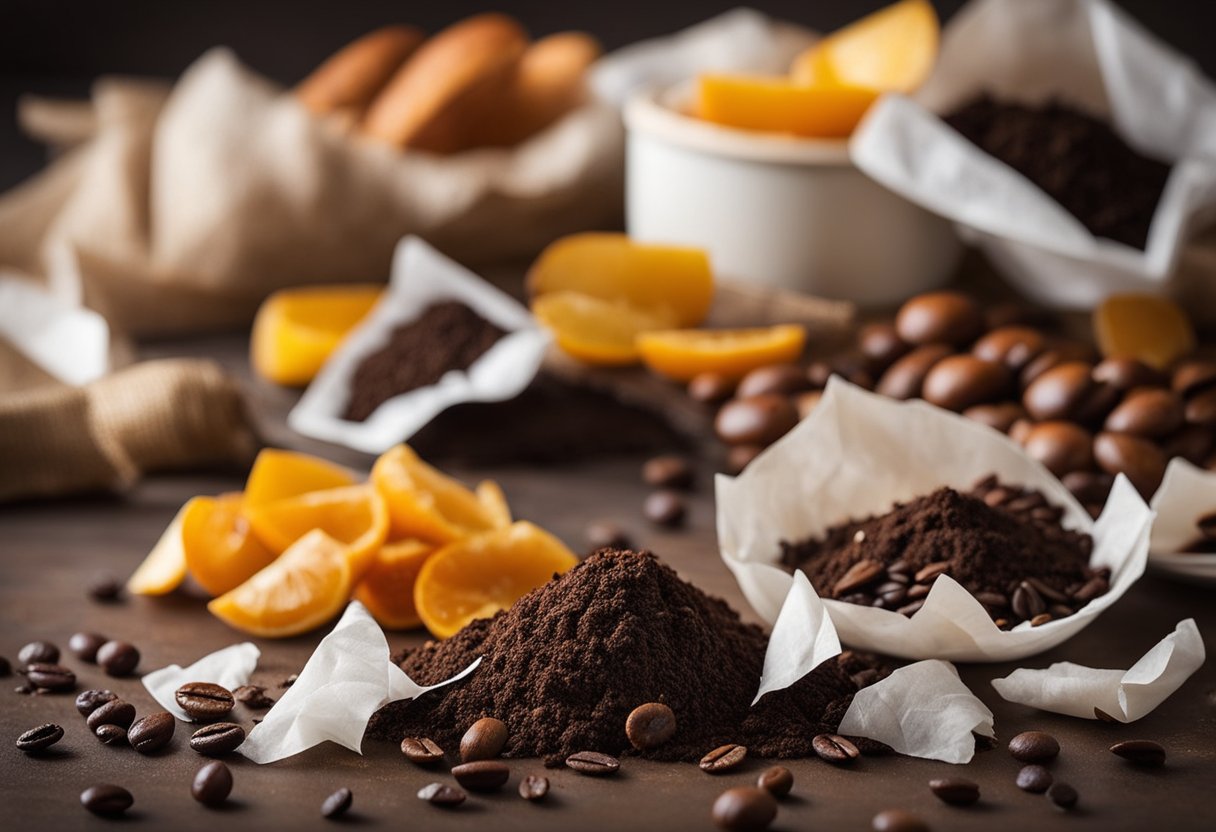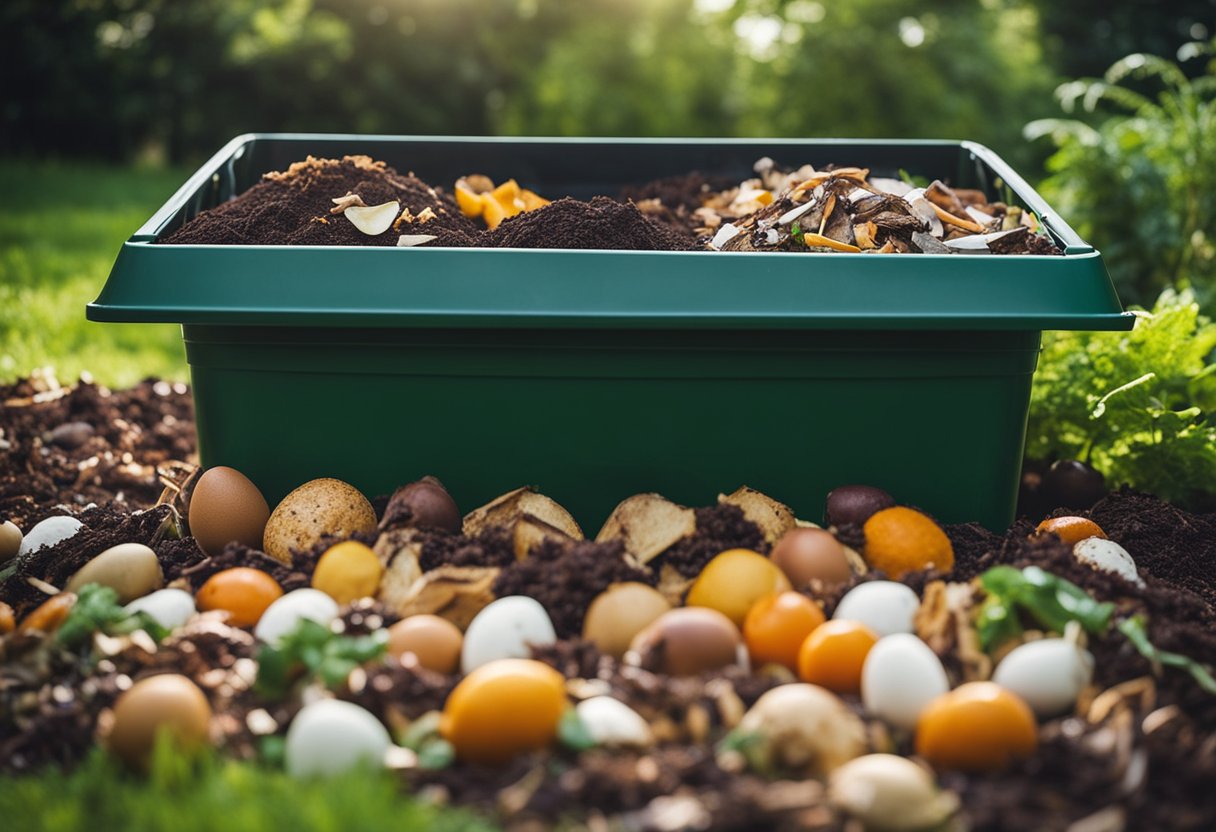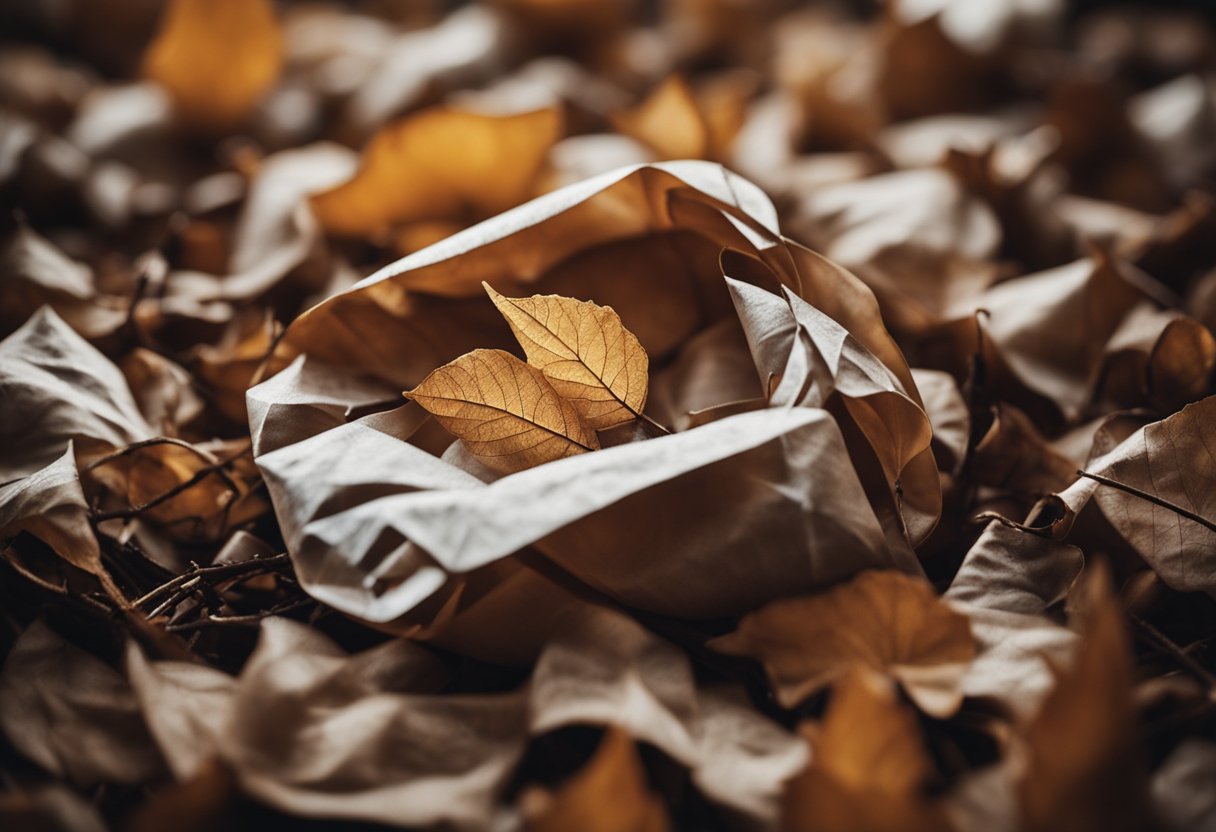As an Amazon Associate I earn from qualifying purchases.
At A Glance
Yes, you can compost tissue paper as it is biodegradable and breaks down relatively quickly in a compost pile. However, the process might be more efficient if the tissue paper is shredded into smaller pieces before being added to the compost. It’s important to ensure that the tissue paper hasn’t been in contact with any harmful chemicals or materials that could disrupt the composting process or introduce toxins into the compost. Additionally, colored or dyed tissue paper might contain chemicals that are not suitable for composting.
Tissue paper is a common household item that is used for various purposes, such as wiping your nose, cleaning up spills, or wrapping gifts. With the increasing awareness of environmental issues, many people are wondering whether tissue paper can be composted. Composting is an eco-friendly way of disposing of organic waste, which can then be used as a natural fertilizer for plants. In this article, I will explore the question of whether tissue paper can be composted and provide you with the information you need to make an informed decision.

The short answer is yes, tissue paper can be composted. Tissue paper is made from wood pulp, which is a natural material that can break down easily in the composting process. However, there are some things to keep in mind when composting tissue paper. For example, tissue paper that has been used to blow your nose or wipe up food spills may contain germs or bacteria, which can be harmful to your compost pile. In addition, tissue paper that has been treated with chemicals or dyes may not be suitable for composting.
To ensure that your tissue paper is safe to compost, it is important to follow some guidelines. First, make sure that the tissue paper is free of any contaminants, such as food residue or chemicals. You can do this by ripping the tissue paper into smaller pieces and inspecting it carefully. Second, avoid composting tissue paper that has been heavily printed or treated with chemicals, as these can be harmful to your compost pile. Finally, mix the tissue paper with other organic materials, such as leaves and grass clippings, to create a balanced compost pile. By following these guidelines, you can safely compost your tissue paper and help reduce waste in a sustainable way.
Understanding Composting
Composting is a natural process that involves the breakdown of organic materials into nutrient-rich fertilizer. This breakdown process is facilitated by micro-organisms such as bacteria, fungi, and worms. These micro-organisms break down the organic materials, such as food scraps, yard waste, and paper, into a dark, crumbly substance called compost.
The breakdown process that occurs during composting involves four main stages:
- The mesophilic stage, where bacteria break down the easily decomposable materials and generate heat.
- The thermophilic stage, where the temperature of the compost pile rises and bacteria continue to break down the organic materials.
- The cooling stage, where the compost pile cools down and mesophilic bacteria take over again.
- The maturation stage, where the compost becomes stable and ready to use as a fertilizer.
When it comes to composting tissue paper, it is important to note that most tissues and napkins are biodegradable and can be safely composted at home. However, it is recommended to avoid tissues that have been used to clean up chemicals or other harmful substances, as these can contaminate the compost and harm the micro-organisms that facilitate the breakdown process.
In general, paper products that are unbleached and uncoated are the best for composting, as they break down more easily and are less likely to contain harmful chemicals. Bleached paper can also be composted in small quantities, as long as the chlorine contamination does not concern you.
Overall, composting is a simple and effective way to reduce waste and create nutrient-rich fertilizer for your garden. By understanding the breakdown process and the role of micro-organisms, you can ensure that your compost pile is healthy and productive.
Types of Compostable Materials

When it comes to composting, there are a variety of materials that can be used to create a nutrient-rich soil amendment. Compostable materials are those that can be broken down naturally by microorganisms, while biodegradable materials will eventually break down but may take much longer to do so.
Some common compostable materials include food waste, coffee grounds, hair, urine, dryer lint, and organic matter such as leaves and grass clippings. These materials are typically high in nitrogen, which is an essential nutrient for plant growth.
Carbon-rich materials, such as paper and cardboard, can also be composted. When composting paper, it’s important to avoid glossy or coated paper, as these materials may contain chemicals that can harm the microorganisms responsible for breaking down the material. Plain white paper, such as notebook paper or printer paper, is safe to compost.
In addition to household waste, natural materials like branches and twigs can also be added to a compost pile or heap. These materials are considered carbon-rich and can help balance out the nitrogen-rich materials like food waste.
Overall, composting is a great way to reduce household waste and create a valuable soil amendment for your garden or plants. By using a combination of nitrogen-rich and carbon-rich materials, you can create a healthy compost pile that will break down quickly and provide essential nutrients for your plants.
Composting Tissue Paper

When it comes to composting, tissue paper can be a bit tricky. The good news is that most tissue paper can be composted, but there are a few things to keep in mind.
First, it’s important to make sure that the tissue paper is free of any synthetic coatings, glitter, or foil. These materials will not break down in the compost pile and can actually contaminate the compost.
If you have tissue paper that has dried tears or saliva, it can still be composted. However, it’s important to avoid adding tissue paper with contents of cold or flu. Most bodily fluids cannot be composted and should be thrown in the trash.
When it comes to colored tissue paper, it’s best to avoid composting it. The dyes used in colored tissue paper can be harmful to the environment and may not break down properly in the compost pile.
Facial tissue, such as Kleenex, can be composted as long as it is free of any lotions or added fragrances. Similarly, paper napkins and paper towels can also be composted as long as they are not heavily soiled with food or other contaminants.
Wrapping tissue, on the other hand, should not be composted. This type of tissue paper is often treated with chemicals to make it more durable and is not biodegradable.
Overall, tissue paper can be composted as long as it is free of any synthetic coatings, glitter, or foil, and is not heavily soiled with bodily fluids or food. By composting tissue paper, you can help reduce waste and create nutrient-rich soil for your garden.
Special Cases for Composting Tissue Paper

When it comes to composting tissue paper, there are a few special cases that you should keep in mind. Here are some things to consider:
Snotty Tissues
While it may be tempting to toss snotty tissues into your compost pile, it’s best to avoid doing so. The germs and bacteria on these tissues can be harmful to your compost pile and can even make you sick if you come into contact with them. Instead, it’s best to dispose of snotty tissues in the trash.
Toilet Paper
Toilet paper can be composted as long as it is not too soiled with bodily fluids. It’s best to use unbleached toilet paper, as it is more eco-friendly and breaks down more easily in the compost pile. Toilet paper rolls can also be composted, but they should be shredded or broken up into smaller pieces first.
Excess Moisture
Tissue paper can be quite absorbent, which makes it a great addition to your compost pile. However, too much tissue paper can lead to excess moisture, which can slow down the composting process. To avoid this, be sure to balance out your tissue paper with plenty of dry, carbon-rich materials like leaves and cardboard.
Dried Tears and Saliva
Tissues that have dried tears or saliva may be composted, but it’s best to avoid adding tissues with contents of cold or flu. These tissues can contain harmful germs that can spread to your compost pile and make you sick. If you do choose to compost tissues with dried tears or saliva, be sure to balance them out with plenty of carbon-rich materials.
Bokashi Compost Accelerator
Bokashi composting is a great way to compost tissue paper quickly and efficiently. Bokashi composting uses a special compost accelerator that is rich in beneficial bacteria, which helps to break down tissue paper and other organic materials more quickly. If you’re interested in bokashi composting, be sure to follow the instructions carefully and use a high-quality compost accelerator.
By keeping these special cases in mind, you can compost tissue paper safely and effectively. Remember to balance out your tissue paper with plenty of carbon-rich materials, avoid adding tissues with harmful germs, and use a high-quality compost accelerator if you’re interested in bokashi composting.
Non-Compostable Materials in Tissue Paper
As mentioned earlier, tissue paper is generally compostable. However, there are some non-compostable materials found in tissue paper that you should be aware of.
One common non-compostable material is glitter. Glitter is often used in tissue paper for crafts or decorations, but it is not biodegradable and should not be added to your compost pile. Foil and shiny coatings are also non-compostable materials that should be avoided.
Another non-compostable material to look out for is tape. When tissue paper is used for wrapping gifts, tape is often used to hold it together. Tape is not compostable and should be removed before adding the tissue paper to the compost pile.
Oils from food or other substances can also contaminate tissue paper and make it non-compostable. If the tissue paper has come into contact with oils or other contaminants, it should not be added to the compost pile.
Additionally, there are some tissue papers that are made with repulped fibers. These fibers are often shorter and weaker than virgin fibers, which can make them more difficult to compost. Bioplastics and microplastics are also non-compostable materials that should be avoided.
In summary, when composting tissue paper, it is important to avoid adding any non-compostable materials such as glitter, foil, shiny coatings, tape, oils, repulped fibers, bioplastics, and microplastics. By being mindful of what you add to your compost pile, you can ensure that your compost is of high quality and free from contaminants.
Environmental Impact of Composting Tissue Paper
Composting used tissue paper is a great way to reduce waste and create nutrient-rich soil. However, it’s important to consider the environmental impact of this process.
When tissue paper is sent to the landfill, it takes up space and releases methane, a potent greenhouse gas that contributes to climate change. Recycling tissue paper is not always possible, as it can be difficult to separate it from other materials, and it may not be accepted by all recycling facilities.
Composting tissue paper is a more eco-friendly option, as it reduces waste and produces a useful product. However, it’s important to compost tissue paper properly to avoid any negative environmental impacts.
One concern is the potential for contamination. Tissue paper that has been used to blow noses or wipe up spills may contain bacteria or other harmful substances. Composting at high temperatures can help to kill off any pathogens, but it’s important to make sure that the compost pile is hot enough and that the tissue paper is thoroughly mixed in.
Another concern is the potential for chemicals to leach into the soil. Some tissue paper products may contain bleach or other chemicals that could be harmful to plants or animals. It’s best to avoid composting tissue paper that has been treated with chemicals, such as single-use paper towels or tissue papers.
Overall, composting tissue paper can be a great way to reduce waste and create nutrient-rich soil. However, it’s important to compost tissue paper properly and avoid any potential negative environmental impacts.
Alternatives to Composting Tissue Paper
While composting tissue paper is a great way to reduce waste, not all tissue paper is suitable for composting. If you have tissue paper that is not compostable, there are several alternatives to consider.
Recycling Tissue Paper
If your tissue paper is not compostable, you can recycle it. Most tissue paper is made from recycled paper, so it can be recycled again. However, it is important to check with your local recycling program to make sure that they accept tissue paper. Some recycling programs do not accept tissue paper because it is too thin and can get caught in the machinery.
Envelopes and Receipts
Envelopes and receipts are often made from thin paper that is not suitable for composting. However, they can be recycled. If you have envelopes or receipts that are not recyclable, consider reusing them instead of throwing them away.
Newspapers
Newspapers are a great alternative to tissue paper. They are made from a thicker paper that is suitable for composting. You can use newspapers to wrap foodstuffs before adding them to your compost pile. Just make sure to remove any plastic or glossy inserts before composting.
Fermentation
If you have food scraps that are not suitable for composting, you can try fermenting them instead. Fermentation is a process that breaks down organic matter without the need for oxygen. This process can be used to break down food scraps, including meat, dairy, and cooked foods.
In conclusion, if you have tissue paper that is not suitable for composting, there are several alternatives to consider. Recycling, reusing, and fermenting are all great options to reduce waste and help the environment.
